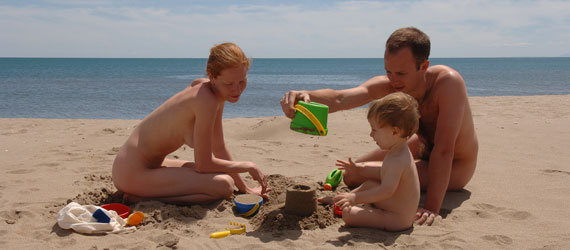Social Nudism: The Effects on Children
Three Studies
By Bill Peckenpaugh
"Is children's exposure to nudity harmful?"
This question looms large in the minds of nudists as some political and religious groups strive to ban social
nudism, and even to classify artwork and photographs portraying mere nudity as"pornography."
Many popular child-rearing "experts" are quick to blame any number of childhood ills on a child's early
exposure to nudity. Can this really be the case? One source of confusion is an inevitable discomfort of many people –
parents and educators included – in respect to anything that smacks of childhood sexuality
The researching of children's sexuality resembles a drive through the desert: long stretches of 'nothing,'
interspersed with brief viewings of activity of some interest.
Alayne Yates (1979) has cited the sparse and confusing history of scholarly study of the general topic of
children's sexuality, and specifically the paucity of concise reference materials for parents and educators
In the United States, research of this nature has historically been seen as unnecessary (the mildest reaction), intrusive
(a common belief among educators is that children's sexuality is the purview of the parents alone), or evil
(especially among individuals and groups subscribing to certain religious codes and dogma).
The impediments to research present a special problem for families and groups that do not share the prevalent
views regarding sexuality in general, and nudity/modesty in particular.
Smith and Sparks (1986) cite numerous examples of families who are nudists but who routinely hide that aspect
of their lives for fear that others will find out and disapprove. They fear disapproval because they do not have any
base of scholarly research to support their beliefs that the body is a normal and healthy entity, and that non-sexual
nudity is not harmful for children (and in fact is beneficial).
Fortunately for nudist families, several researchers have taken an interest in the subject of nudity and children's
development. Unfortunately, few others have chosen to replicate their research, possibly due to the reasons outlined
by Yates.
This article will review and assess three relevant research studies:
• Robin Lewis and Louis Janda's 1988 study, "The relationship between adult sexual adjustment and childhood
experiences regarding exposure to nudity, sleeping in the parental bed, and parental attitudes toward sexuality";
• Ron and Juliette Goldman's 1981 study, "Children's perceptions of clothes and nakedness: A cross-national
study";
• Marilyn Story's 1979 study, "Factors associated with more positive body self-concepts in preschool children."
Childhood Influences On Adult Adjustment
Lewis and Janda (1988) examined the relationship between adult sexual adjustment and childhood exposure to
nudity, sleeping in the parental bed, and parental attitudes toward sexuality. They pointed out that prior studies had
presented conflicting findings: Some researchers had warned of dire consequences for children viewing nudity, while
others had reported benefits.
A common theme was that if parents "forced" themselves to be nude in front of the child (in order to educate the
child about basic anatomical differences), and the parents were not: comfortable with this nudity, the experience
would likely be neutral or negative. It seems that the issue, then, is not nudity per se, but family attitudes toward
acceptable and comfortable behavior.
Lewis and Janda recruited 210 undergraduate university students as subjects for their study. All subjects completed
an extensive questionnaire measuring three basic experiences during childhood (defined as the period from
birth to eleven years): sleeping in bed with the parents; parental attitudes toward and comfort with sexuality; and
viewing parents, siblings, and friends nude. Information on current sexual cormfort and adjustment was also obtained
using an extensive questionnaire.
The study found a positive correlation between childhood exposure to nudity and. adult sexual comfort. The
authors point out, however, that some would see this as a reason to prevent childhood exposure to nudity, as their
measures on comfort included acceptance of lifestyles that some would consider immoral or undesirable (such as
premarital sex, or acceptance of homosexuality).
The other factors (sleeping in the parental bed and parental comfort/acceptance of sexuality), while not germane
to the narrow scope of this discussion, also demonstrated a positive correlation with childhood exposure and adult
sexual adjustment and comfort.
For males aged 0-5 nudity was inversely related to reported discomfort about affection and physical contact; in
other words, increased exposure to nudity was related to less discomfort regarding affection and physical contact.
Nudity during 0-5 was not significantly related to any other adjustment variables. Nudity during ages 6-11 was positively
related to increased self-esteem and knowledge about sex.
For females, nudity during ages 0-5 was related only to increased frequency of sex related to others (i.e., more
frequent sexual encounters). Nudity during 0-5 was not related to any other adjustment variables. Nudity during 6-11
was positively related to an increased tendency to engage in casual sexual relationships.
These results suggest that children's exposure to sleeping in the parental bed and exposure to nudity are not
related to sexual maladjustment. In fact, exposure to these events was correlated to higher self-esteem and comfort
with sexuality. In addition, children whose parents were comfortable and accepting of sexuality had even higher
levels of self-esteem and comfort.
These results would suggest that the anecdotal reports of "damage" caused by these childhood events are
exceptions to the rule, and that commonly held beliefs and societal taboos need to be re-examined.
Children's Perceptions of Nudity & Society
Many parents are reluctant to allow their children to be naked during play or sleep. When they explain this to the
child they often do not use moral reasons, but pseudo-practical ones (such as, "You might catch a cold").
Parents also transfer their discomfort with nakedness to the naming of body parts, often using vague terms such
as "it" or "down there," rather than penis, scrotum, vulva, clitoris, and anus. Frequently, the genitals and perineum
are not mentioned at all.
Ron and Juliette Goldman (1981) interviewed 838 children from North America, England, Australia, and Sweden.
The children ranged in age from five to 15 years old. Each child was individually interviewed and asked
questions designed to elicit responses indicating the child's understanding of wearing clothing, nudity (as viewed by
society as a whole), and modesty.
Researchers asked the children three questions: "Suppose we all lived in a nice warm place; should we need to
wear clothes?" "Why should this be so?" (i.e., what are the reasons for saying "yes" or "no") and, "Some people feel
shy or funny about [revealing] certain parts of the body; why should this be so?"
There were variations in the exact wording for younger or slower [sic] children, but after trial interviews the
above questions appeared to have little ambiguity for children of all ages. The responses were coded and scored in
order to assess each child's level of cognitive reasoning for the answers given. No references were made to the family
nudity status, although this may have been an influential factor.
This study found that English-speaking children were the most adamant that clothes were necessary, even in hot
climates; and North American children were the most insistent of all. English speakers were also less likely to
advance to the highest level of moral thinking with regard to reasons for embarrassment when nude, and reasons for
wearing or not wearing clothes.
The Swedish children seemed to score consistently higher, and seemed to be much less clothes-insistent although
they live in a colder climate and would have more reason to expect that clothing should be worn. The Goldmans
point out that sex education in Swedish schools is compulsory after age eight, and the northern European traditions of
sauna and FKK ("Freikörperkultur," or "free body culture") are well established in Sweden.
This cultural difference is not as evident when examining the reasons for wearing clothes and why people might
feel embarrassed when naked. The picture revealed by children's perceptions was one in which nakedness, and especially
sexual nakedness, is strongly tinged with guilt.
As age increases, the need for conformity becomes more apparent to children. It was evident through many
children's answers that low-level thinking was conveyed through parents' modesty training. The "pseudo-practical"
reasoning mentioned above is used. Rather than revealing parental discomfort with nudity and sexuality, the parent
tries to appeal to a concrete, rational reason.
It does indicate, however, that the sex education process has to overcome myriad adult mythologies and rationalizations
that prevent children from understanding, accepting, and enjoying the body and its sex organs as natural and
normal.
Nudist and Non-Nudist Perceptions At Variance
Body self-concept is an important part of overall self-concept because individuals function within the boundaries
of their physical bodies. Lower or negative body self-concept scores have been associated with undue anxiety, lessened
ability to enter into intimate expressive relationships, and decreases in motor abilities.
Three- to five-year-old children can validly identify body self-concept. Numerous studies involving older
children have indicated significant differences between male and female responses to body self-concept tests – but no
such difference has been well defined in younger children. In addition, no earlier studies had examined the role of
family social nudity classification on body self-concept development. This study may be the most useful resource for
nudist families, as it tries to establish a relationship between the two.
Marilyn Story (1979) interviewed 264 three- to five-year-old children and their parents. These subjects were
chosen and matched based on family nudity status: social nudist, "at-home-only nudist," or non-nudist. Subjects were
all North Americans, with approximately equal numbers sampled from all geographic regions in the United States.
The parents were individually interviewed to determine the children's ages, sexes, weights, and birth order. Each
child was given an individually administered test, consisting of the interviewer pointing to a body part on a line
drawing of a nude child the same race and sex as the child being interviewed, and asking, "Do you like your
_______ ?"
This was repeated for 16 body parts (although the study did not state which specific body parts were listed).
While viewing the drawings, the child was also asked, "What part of your body do you like best? Why?" and "What
part of your body do you like least? Why?" The answers to these questions were categorized and assigned numerical
values.
For non-nudist children, answers to the questions "What part of your body do you like best?" and "What part of
your body do you like least?" showed no relationship to race or geographical location. Gender was significant, with
females most often liking their hair, eyes, nose or mouth, and boys liking their arms or genitals; however, non-nudist
girls and boys most often named their genitals as least liked.
For nudist children (including "at-home-only" nudists), answers to the above questions yielded very different
results. Both boys and girls most often stated that their genitals were the best liked part. Nudist boys and girls also
most often answered that they had no body parts they did not like (although they often expressed dissatisfaction with
their skin: not because of racial coloring or deformity, but because of sunburn or too little tanning).
Story also found that nudism was a more important variable in body self-concept than were sex, race, and geographical
area. The relationship between nudism and body part least liked was significant (roughly a 1 in 10,000
probability of being only a random result), as discussed above.
In the analysis of the 16 body part test, nudist males scored higher than non-nudist males and females, and nudist
females scored higher than non-nudist males and females. When nudity classification was not a variable, the
differences in scores were far less significant, with nudist males scoring higher than nudist females, and non-nudist
males scoring higher than non-nudist females.
Family nudism was found to have a higher correlation to increased body self-concept than did sex, race, or
geographical area. Nudist children consistently scored higher than non-nudist children did in all areas of body
acceptance, self-concept, and self-image.
Conclusion: Nudity Is Beneficial to Family & Society
The results of the research presented would seem to speak clearly and with force:
Children's exposure to nudity is not only not harmful, it appears to be beneficial. Children who are raised
as nudists (or in nude-friendly families) grow up to be adults who are comfortable with their bodies and their
sexuality.
However, this seemingly clear relationship is not at all clear to most parents, nudist or non-nudist.
Yates (1978) theorizes that most parents are unaware of these studies or the patterns they reflect for two reasons.
• First, nudists are still widely (and erroneously) perceived in our society as sexual deviants. Those who are not
nudists generally have no direct personal experiences to disprove the fallacy; many nudists are afraid to reveal
their status for fear of being ridiculed, prosecuted or persecuted.
• Second, research into human sexuality provided amazing advances in our knowledge of adult sexuality in the
last one hundred years and this was seen as appropriate, as adults are clearly sexual beings. Parallel research
with regard to children has advanced much more slowly, as researchers are loath to study this topic.
What little research has been done has generally not been replicated. The neglect of replication has led to a general
absence of credence among those who rely on the literature for their professional opinions – and these people are
the ones who directly advise parents.
Thus, we are left with the advice of Dr. Spock, who warned us of dire consequences resulting from children's
exposure to nudity but who performed no research of his own – apparently his conclusions were based on one anecdotal
incident involving his own son.
Dr. Joyce Brothers, who warns parents of "terrible guilts and frustrations" that children suffer from being
exposed to normal nudity, also performed no research of her own and apparently based her conclusions on her work
with emotionally disturbed children (Smith and Sparks, 1986).
We see from Smith and Sparks that some widely published "experts" are not experts at all, but rather individuals
with personal opinions who also happen to be widely read by parents who trust that those opinions are based on
formal research.
|





